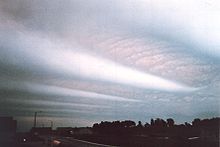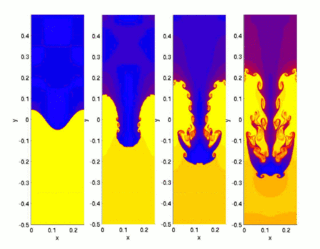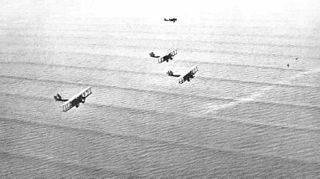The gravity wave represents a perturbation around a stationary state, in which there is no velocity. Thus, the perturbation introduced to the system is described by a velocity field of infinitesimally small amplitude,  Because the fluid is assumed incompressible, this velocity field has the streamfunction representation
Because the fluid is assumed incompressible, this velocity field has the streamfunction representation

where the subscripts indicate partial derivatives. In this derivation it suffices to work in two dimensions  , where gravity points in the negative z-direction. Next, in an initially stationary incompressible fluid, there is no vorticity, and the fluid stays irrotational, hence
, where gravity points in the negative z-direction. Next, in an initially stationary incompressible fluid, there is no vorticity, and the fluid stays irrotational, hence  In the streamfunction representation,
In the streamfunction representation,  Next, because of the translational invariance of the system in the x-direction, it is possible to make the ansatz
Next, because of the translational invariance of the system in the x-direction, it is possible to make the ansatz

where k is a spatial wavenumber. Thus, the problem reduces to solving the equation

We work in a sea of infinite depth, so the boundary condition is at  The undisturbed surface is at
The undisturbed surface is at  , and the disturbed or wavy surface is at
, and the disturbed or wavy surface is at  where
where  is small in magnitude. If no fluid is to leak out of the bottom, we must have the condition
is small in magnitude. If no fluid is to leak out of the bottom, we must have the condition

Hence,  on
on  , where A and the wave speed c are constants to be determined from conditions at the interface.
, where A and the wave speed c are constants to be determined from conditions at the interface.
The free-surface condition: At the free surface  , the kinematic condition holds:
, the kinematic condition holds:

Linearizing, this is simply

where the velocity  is linearized on to the surface
is linearized on to the surface  Using the normal-mode and streamfunction representations, this condition is
Using the normal-mode and streamfunction representations, this condition is  , the second interfacial condition.
, the second interfacial condition.
Pressure relation across the interface: For the case with surface tension, the pressure difference over the interface at  is given by the Young–Laplace equation:
is given by the Young–Laplace equation:

where σ is the surface tension and κ is the curvature of the interface, which in a linear approximation is

Thus,

However, this condition refers to the total pressure (base+perturbed), thus

(As usual, The perturbed quantities can be linearized onto the surface z=0.) Using hydrostatic balance, in the form 
this becomes

The perturbed pressures are evaluated in terms of streamfunctions, using the horizontal momentum equation of the linearised Euler equations for the perturbations,

to yield 
Putting this last equation and the jump condition together,

Substituting the second interfacial condition  and using the normal-mode representation, this relation becomes
and using the normal-mode representation, this relation becomes 
Using the solution  , this gives
, this gives
























































